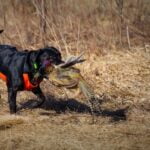Training a dog to detect low blood sugar can be an essential skill for individuals with diabetes. As part of their daily management, many people rely on the help of specially trained dogs to alert them when their blood sugar levels are dangerously low. In this article, we will explore the importance of this training and the science behind a dog’s ability to detect low blood sugar.
The ability of dogs to detect changes in their owners’ blood sugar levels is nothing short of remarkable. Through their keen sense of smell, dogs can pick up on subtle changes in body chemistry that occur when blood glucose levels begin to drop. This skill is particularly valuable for individuals with diabetes who may experience sudden and severe drops in blood sugar, putting them at risk for serious health complications.
In order to successfully train a dog to become a reliable detector of low blood sugar, it’s important to understand the process involved and select the right type of dog for this specialized training. Additionally, proper preparation and ongoing reinforcement are crucial factors in ensuring that your dog can effectively assist in managing low blood sugar.
We will delve into these topics as we guide you through the step-by-step process of training your dog for this critical task.
The Science Behind a Dog’s Ability to Smell Low Blood Sugar
To understand how dogs can detect low blood sugar, it’s important to delve into the biological factors at play. When a person experiences hypoglycemia, their body releases certain chemicals, such as isoprene, that are undetectable to humans but are certainly not unnoticed by dogs. These unique scent markers allow dogs to alert their owners to the presence of low blood sugar before it reaches a critical level.
In order to pick up on these subtle yet crucial scent changes, dogs possess up to 300 million olfactory receptors in their noses, compared to a human’s mere 5-6 million. This remarkable capability, combined with their exceptional training, makes them invaluable companions for individuals with diabetes who need assistance in managing their condition.
- 300 million olfactory receptors make dogs excellent at detecting scents
- Dogs can pick up on subtle chemical changes in the body when blood sugar levels drop
- They are trained to recognize specific scent markers associated with low blood sugar
Selecting the Right Dog for Training
When it comes to training a dog to detect low blood sugar, choosing the right breed is essential. While any dog can be trained to do so, certain breeds are more naturally inclined towards this type of work. Some of the most popular breeds for diabetic alert training include Golden Retrievers, Labrador Retrievers, Poodles, and mixed breeds. These dogs are known for their intelligence, ease of training, and strong sense of smell.
It’s also important to consider the individual temperament and personality of a dog when selecting one for training. The ideal diabetic alert dog should be calm, focused, and eager to please. Dogs with a gentle disposition and an affinity for human interaction are best suited for this type of training.
In addition to breed and temperament, age is also a factor to consider when selecting a dog for diabetic alert training. Some trainers recommend starting with a puppy as young as eight weeks old, while others prefer to work with adult dogs. Ultimately, the right choice will depend on the trainer’s experience level and personal preferences.
| Factors to Consider | Considerations |
|---|---|
| Breed | Golden Retrievers, Labrador Retrievers, Poodles |
| Temperament | Calm, focused, gentle disposition |
| Age | 8 weeks old or adult depending on preference |
Preparing for Training
Understanding the Importance of Proper Equipment
Before beginning the training process, it’s important to gather all the necessary supplies and tools. The right equipment can make a significant difference in your dog’s ability to effectively detect low blood sugar levels. One crucial piece of equipment is a treat pouch or something similar to conveniently carry treats during training sessions.
Additionally, having a clicker can be helpful in marking the exact moment when your dog exhibits the desired behavior. A comfortable and secure harness or vest will also be needed for when your dog begins working in real-life situations.
Selecting High-Quality Treats
Choosing high-quality, desirable treats is essential for maintaining your dog’s motivation during training sessions. Opt for small, soft treats that are easy for your dog to eat quickly and are particularly appealing to them. It’s also advisable to have a variety of treats on hand, as this can help keep your dog engaged and interested in the training process.
Creating a Positive Environment
In addition to having the right equipment and treats, creating a positive environment for training is important for success. Find a quiet space with minimal distractions where you can work with your dog consistently. It’s also essential to have patience and an encouraging attitude throughout the training process. Building a strong bond with your dog based on trust and positivity will set the stage for successful low blood sugar detection training.
By ensuring that you have the right supplies and tools, high-quality treats, and a positive environment, you’ll be well-prepared to begin the process of teaching your dog to detect low blood sugar levels.
Step-by-Step Training Process for Teaching Your Dog to Detect Low Blood Sugar
Basic Obedience Training
Before delving into training your dog to detect low blood sugar, it’s essential to ensure that they have solid basic obedience skills. This includes commands such as sit, stay, come, and heel. A well-behaved and obedient dog will make the training process for detecting low blood sugar much smoother.
Introducing the Scent
The next step in training your dog to detect low blood sugar is to introduce them to the specific scent associated with hypoglycemia. This can be done using a cotton ball or gauze pad that has been in contact with a sample of your breath when experiencing low blood sugar.
Allow your dog to smell this item and then immediately reward them with a treat. Repeat this process multiple times so that your dog begins to associate the scent of low blood sugar with something positive.
Pairing the Scent With Behavior
Once your dog has become familiar with the scent, it’s important to begin associating it with a specific behavior. For example, if you experience symptoms of low blood sugar such as shakiness or dizziness, use a cue word such as “alert” while giving your dog the scent to smell. Reward them when they show any sign of recognition or acknowledgment of the scent.
By following these steps, you can gradually train your dog to recognize and alert you when they detect low blood sugar, ultimately providing assistance in managing this health condition effectively.
Reinforcing and Maintaining Your Dog’s Ability to Detect Low Blood Sugar
Consistent practice is key when it comes to maintaining your dog’s ability to detect low blood sugar. Regular training sessions, even after the initial training period, will help keep your dog sharp and attentive. These sessions can involve simulated scenarios where you intentionally lower your blood sugar levels and observe how your dog responds. This ongoing practice will not only reinforce their training but will also ensure that they are prepared for real-life situations.
In addition to regular practice, it is essential to keep an eye on your dog’s health and well-being. Just like humans, dogs can experience changes in their senses over time.
Regular check-ups with a veterinarian can help monitor any potential issues that may affect your dog’s ability to detect low blood sugar levels effectively. By actively reinforcing their training and monitoring their overall health, you can ensure that your dog remains a reliable partner in managing low blood sugar levels.
| Training Techniques | Frequency of Training |
|---|---|
| Positive reinforcement such as praise and treats | Regular training sessions even after the initial training period |
| Consistent practice with simulated scenarios | To maintain sharpness and attentiveness |
| Veterinary Check-ups | To monitor any potential issues affecting a dog’s ability to detect low blood sugar levels effectively. |
Real-Life Applications
Training your dog to detect low blood sugar can have a significant impact on managing this condition. Once your dog has been successfully trained to recognize the scent of low blood sugar, they can assist in alerting you when your levels are dropping, giving you the opportunity to take action before it becomes a serious issue. Here are some real-life applications of how your dog can assist in managing low blood sugar:
- Alerting you at home: Your trained dog can notify you if they detect the scent of low blood sugar, allowing you to check your levels and take appropriate action.
- Accompanying you in public: When out in public, your dog can provide an early warning if your blood sugar is dropping, giving you the chance to address the situation before it becomes a medical emergency.
- Assisting during sleep: Some individuals may experience dangerous drops in blood sugar while they sleep. A trained dog can wake you up if they sense that your levels are becoming too low, preventing potential complications.
These real-life applications demonstrate the practical and potentially life-saving role that a well-trained diabetic alert dog can play in managing low blood sugar levels. By working together with these specially trained animals, individuals with diabetes can gain an added layer of support and protection in their daily lives. Remember that consistent training and reinforcement are key to maintaining your dog’s ability to effectively detect low blood sugar and respond appropriately.
Troubleshooting Common Challenges in Training a Dog to Detect Low Blood Sugar
In conclusion, training a dog to detect low blood sugar levels can be a life-changing skill for individuals with diabetes. While there may be common challenges that arise during the training process, it’s important to remember that with patience and consistency, these challenges can be overcome. As a dog owner, understanding the importance of this training and being committed to the process is essential in ensuring success.
The science behind a dog’s ability to smell low blood sugar is fascinating and truly showcases the incredible bond between humans and their canine companions. By selecting the right dog for training and properly preparing for the process with the necessary supplies and tools, you can set yourself and your dog up for success.
Once your dog has been trained to detect low blood sugar, it is crucial to reinforce and maintain their ability through regular practice and positive reinforcement. Additionally, understanding the real-life applications of how your dog can assist in managing low blood sugar will further highlight the significance of their training. With dedication and perseverance, individuals can successfully train their dogs to detect low blood sugar levels and provide invaluable support in managing diabetes.
Frequently Asked Questions
Can I Train My Dog to Know When My Blood Sugar Is Low?
Yes, it is possible to train your dog to recognize when your blood sugar is low. Through positive reinforcement and consistent training, dogs can be taught to alert their owners when they detect changes in their blood sugar levels. This can be a valuable skill for individuals with diabetes, as it provides an added layer of support and safety.
Can I Train My Dog to Be a Diabetic Alert Dog?
With the right training, some dogs can become diabetic alert dogs. These specially trained dogs are able to detect fluctuations in their owner’s blood sugar levels and provide a timely alert, allowing their owners to take necessary actions to manage their condition.
The process of training a diabetic alert dog involves patience, consistency, and working closely with a professional trainer.
Can Untrained Dogs Detect Low Blood Sugar?
While untrained dogs may not have the same level of reliability or consistency as trained diabetic alert dogs, there have been instances where untrained pet dogs have instinctively detected low blood sugar in their owners.
However, relying on an untrained dog to consistently detect low blood sugar is not as reliable as having a dog that has undergone specialized training for this purpose.

Welcome to the blog! I am a professional dog trainer and have been working with dogs for many years. In this blog, I will be discussing various topics related to dog training, including tips, tricks, and advice. I hope you find this information helpful and informative. Thanks for reading!





